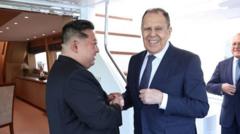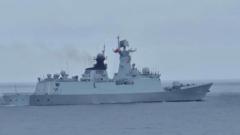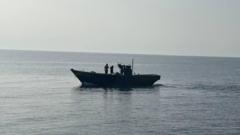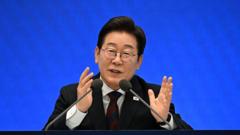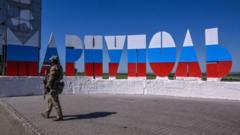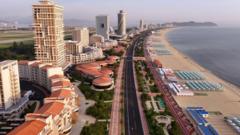Kim Jong Un's response to a disastrous warship launch reflects a deliberate strategy to bolster loyalty to the regime. By publicly addressing failure and showcasing rapid recovery, North Korea demonstrates its intent to advance its naval capabilities and reshape narrative control.
North Korea's Warship Incident: A Lesson in Regime Resilience and Propaganda
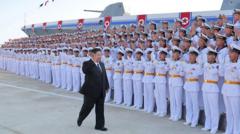
North Korea's Warship Incident: A Lesson in Regime Resilience and Propaganda
The recent capsizing and swift relaunch of a North Korean warship highlight the regime's ability to turn failures into political victories under Kim Jong Un.
In a striking display of political strategy, North Korea's recent warship launch debacle has surfaced as a revealing moment for Kim Jong Un's regime. Last month, a newly built warship capsized during its launch, drawing global media attention not due to injuries or significant damage, but because of Kim's vehement reaction toward the incident.
Upon witnessing the mishap, which unfolded in front of spectators, Kim Jong Un dubbed the event "a criminal act" that threatened the nation's prestige. He demanded immediate repairs and the punishment of those responsible, leading to the detainment of four party officials. This incident can be understood less as a mere naval failure and more as an illustration of the regime's approach to managing public perception.
Experts assert that this naval misstep underscores North Korea's broader ambition to construct a formidable nuclear-capable navy, addressing its perceived inferiority relative to regional rivals like South Korea, Japan, and the United States. Kim has long prioritized the modernization of the fleet—a plan that involves these newly constructed destroyers, which are the largest vessels in North Korean history, capable of launching nuclear short-range missiles.
However, the capsizing exposed North Korea's maritime construction limitations and was particularly humiliating for Kim, who had hoped to showcase military prowess. Yet, analysts suggest that Kim's public handling of the incident reveals a sophisticated pivot in the regime's propaganda tactics. Unlike his predecessors, who ignored failures, Kim has begun to invite some transparency when confronting setbacks. Rachel Minyoung Lee, an expert in North Korean propaganda, argues that acknowledging such missteps serves to demonstrate active governance and accountability, thereby reinforcing citizens' loyalty.
The rapid repair of the warship—completed in just over three weeks—was a significant move for Kim, countering skepticism regarding his regime's industrial capabilities. By praising workers and honoring those who have sacrificed, Kim has sought to instill a sense of devotion among the populace, marking a shift from the portrayal of an infallible leadership to one that recognizes human effort and labor.
This episode not only reflects Kim's tactical adaptability but also illustrates the regime's broader objective: establishing a naval force capable of asserting influence on a global scale. As analysts warn, should North Korea succeed in transforming its navy from regional defense to offensive capabilities, the implications for international security could be profound. Thus, vigilance and strategic preparedness will remain paramount in the face of North Korea's ongoing military ambitions.
In summary, the recent warship incident effectively encapsulates the duality of failure and success within North Korea's political landscape, showcasing Kim Jong Un's adeptness at controlling the narrative and reinforcing regime legitimacy amidst emerging challenges.


